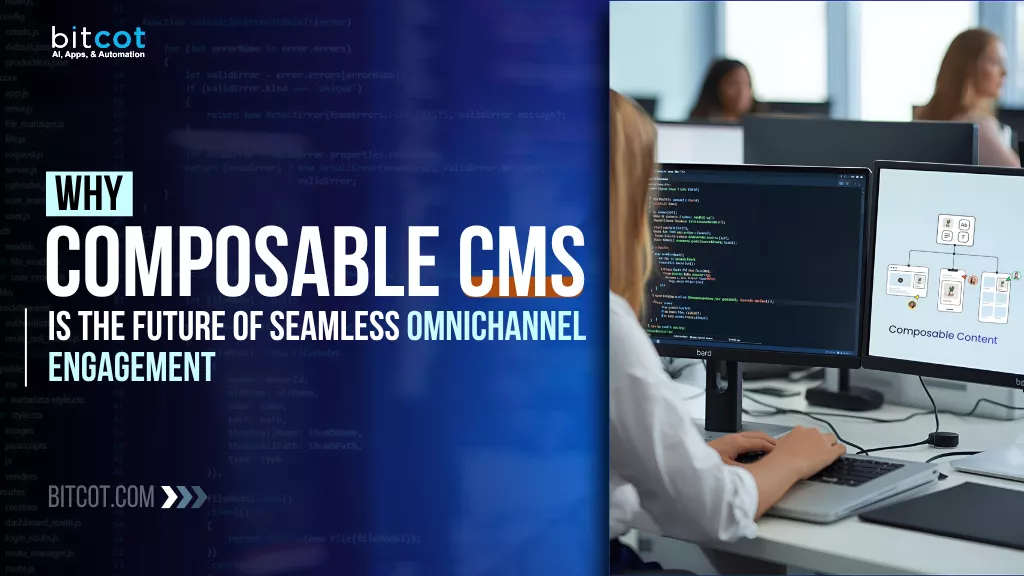
When it comes to large-scale projects, every enterprise knows the stakes are high.
Whether you’re revamping an outdated system, launching a new customer-facing platform, or consolidating various applications into one cohesive solution, enterprise web development plays a critical role in ensuring that everything runs smoothly.
However, building web applications at this scale comes with its own set of unique challenges that can easily make even the most seasoned teams break into a sweat.
From the complexity of integrating old systems with new technologies to keeping everything secure and accessible, large-scale web development is not for the faint of heart. But here’s the good news: every challenge has a solution. And with the right approach, the hurdles that come with these projects can be tackled successfully.
In this blog, we’ll walk through some of the biggest challenges faced during enterprise web development for large-scale projects. We’ll also share practical solutions that can help you navigate these obstacles efficiently, ensuring that your web applications are scalable, secure, and provide a top-tier experience for your users.
What is Enterprise Web Development?
At its core, enterprise web development refers to the process of designing, building, and maintaining large-scale web applications that cater to the complex needs of businesses.
Unlike consumer-focused websites or apps, enterprise-level solutions are designed to handle the operational intricacies of a company. They manage everything from internal workflows and communication to customer interactions, financial transactions, and more.
Think of enterprise web app development as the backbone of a company’s digital operations. These applications are often highly customizable and scalable, enabling businesses to manage large amounts of data, integrate with existing software systems, and provide seamless user experiences across various platforms.
What sets enterprise web application development apart from standard web development is the scale and complexity of the systems involved. Enterprise applications often have a massive user base, integrate with multiple systems, and need to ensure high levels of security and performance.
These applications can range from customer relationship management (CRM) platforms, enterprise resource planning (ERP) systems, supply chain management tools, to employee intranets or content management systems (CMS).
Here are a few key characteristics that define enterprise web development:
- Complexity: Enterprise systems often need to support a wide range of features and users, making them more intricate than typical web applications.
- Scalability: The infrastructure must be able to grow alongside the business, handling increasing amounts of data, users, and requests without compromising performance.
- Integration: These applications typically need to work seamlessly with existing software systems, such as accounting, HR, or inventory management tools.
- Security: With sensitive company and customer data, enterprise applications must prioritize robust security measures to prevent data breaches and comply with regulations.
- Reliability: Enterprise solutions need to operate 24/7 without downtime, ensuring that business operations continue uninterrupted.
In essence, corporate web development goes beyond just building a website. It’s about crafting custom software solutions that help large organizations run more efficiently, solve specific business problems, and scale operations effectively.
And with such complex requirements, it’s no surprise that enterprise web development comes with its own set of unique challenges, which we’ll explore in this article.
Types of Enterprise Web Development: Websites vs. Web Applications
While both enterprise website development and web application development are crucial for modern businesses, they serve different functions, and understanding the distinction between them can provide clarity as to which type of solution your organization needs.
1. Enterprise Websites
Enterprise website solutions are the digital face of a company. They serve as the central hub for a company’s online presence, providing information about the business, its products or services, and its values.
What is an enterprise-level website? It’s defined by its scale, importance, and integration with the business’s overall digital strategy.
These websites are typically static or content-driven, focusing on providing users with general information, news, or promotional content.
Key Features
- Content Management: The website content (articles, blog posts, images, etc.) is typically managed through a CMS (Content Management System).
- Informational Focus: The goal is to inform, engage, and sometimes convert users into leads or customers.
- SEO: Corporate websites development is optimized for search engines, helping the business gain visibility online and reach a broader audience.
Why They’re Important
An enterprise website is often the first point of contact for potential customers, partners, and investors. It serves as the public-facing presence of a business, helping to build brand awareness, convey credibility, and drive initial interest in a company’s offerings. To effectively manage enterprise-scale websites, a solid content and infrastructure strategy is essential.
Example
A large hospital might partner with an enterprise website development company to build an enterprise healthcare website that showcases its medical services, department information, patient resources, doctor directories, appointment scheduling, and health news updates.
2. Enterprise Web Applications
Unlike websites, web applications are interactive, user-driven platforms that provide a specific function or service to users. They often support complex tasks and workflows and are essential for day-to-day business operations. These applications are designed to handle dynamic content, user interactions, and real-time data processing.
Key Features
- Interactivity: Web applications are highly interactive and enable users to perform tasks like making purchases, sending messages, managing accounts, or analyzing data.
- Complexity: These applications often support multiple users, integrate with databases, and have multiple layers of functionality.
- User Authentication: Many web applications require secure login, role-based access, and personalized features.
- Real-time Data: Web apps can handle real-time transactions and updates, making them ideal for business operations.
Also Read: Enterprise Application Development: Process, Types, Benefits and Cost
Why They’re Important
Enterprise-level web application development is essential for internal business processes and customer-facing services that require real-time interaction or data processing. These systems help organizations operate efficiently, enabling collaboration, streamlining workflows, and improving customer engagement.
Example
An ERP system, where employees can log in to manage inventory, financials, and other company resources, is a typical example of a web application. Similarly, a CRM system enables teams to manage customer data, sales pipelines, and support tickets.
| Aspect | Enterprise Website | Enterprise Web Application |
| Purpose | Informational and promotional. | Functional and interactive. |
| User Interaction | Low interaction (users mainly browse). | High interaction (users perform actions or tasks). |
| Complexity | Simple structure and design, often content-driven. | Complex workflows, business logic, and real-time features. |
| Data Handling | Limited to static content (text, images, videos, etc.). | Handles dynamic data, databases, and real-time updates. |
| Technology Stack | Front-end technologies (HTML, CSS, JavaScript). | Full-stack development (front-end + back-end technologies). |
| Example | A company’s “About Us” page, product info, blog, etc. | CRM, ERP systems, project management tools, etc. |
Key Challenges and Solutions in Enterprise Web Development
When navigating large-scale web projects, the development challenge is far greater than just writing code.
You’re balancing millions of customers, decades of system history, immense data volume, and strict regulatory compliance. The sheer scale means small technical problems can rapidly become massive business risks.
Here are the critical obstacles modern enterprise leaders must understand, and the strategic solutions that drive long-term business value.
Challenge 1: Innovation Paralysis from Legacy Systems (The Classic Car Problem)
Most large companies rely on core monolithic applications: single, massive systems that handle critical functions like inventory or finance. While reliable, these systems are rigid and expensive.
The business consequence is innovation paralysis: making any minor update or launching a new customer feature becomes a slow, high-risk, and costly endeavor, often requiring the entire system to be taken offline. This directly impacts your competitive speed in the marketplace.
The Strategic Solution: Phased Modernization (The Strangler Fig)
Instead of a multi-million-dollar, risky “rip and replace” project, leading enterprises adopt a phased approach. They use Microservices and modern APIs to build new, nimble functions around the old system.
This method allows you to incrementally replace the outdated core functionality without business interruption, ensuring your public-facing websites and internal apps can integrate modern capabilities without waiting for a total overhaul. This significantly reduces risk and accelerates time-to-market.
Challenge 2: Unacceptable Risk from Security and Regulatory Failures
For large organizations, data is gold, making you a prime target. Security failures don’t just lead to technical downtime; they lead to reputational damage, massive regulatory fines (like GDPR or HIPAA penalties), and loss of customer trust.
Traditional security checks done late in the development cycle are simply too slow and leave too much exposure time.
The Strategic Solution: Automated Risk Mitigation (DevSecOps and Zero Trust)
The solution is to automate security and make it continuous. DevSecOps integrates security tests directly into the daily workflow, catching vulnerabilities immediately rather than right before launch.
Furthermore, implementing a Zero Trust architecture, which assumes no user or system is inherently safe, even inside the company network, is crucial.
This approach ensures every transaction is verified, significantly lowering the chance of a successful breach and reducing your overall liability.
Challenge 3: Protecting Revenue During Unpredictable Traffic Spikes
Your company’s public website or core internal application must perform perfectly under maximum, unpredictable load. A major product launch or seasonal event can cause a catastrophic crash, leading to direct, quantifiable revenue loss and severely damaged customer experience.
Maintaining High Availability, ensuring the application is virtually always online, is non-negotiable.
The Strategic Solution: Elasticity via Cloud-Native Architecture
The safest place to run critical applications is in the public cloud. We utilize Cloud-Native strategies that enable horizontal scaling. This simply means the system automatically duplicates and distributes its components across multiple servers when demand is high, effortlessly managing huge traffic spikes.
The crucial business benefit is elasticity: you only pay for the massive capacity when you need it, protecting revenue without over-investing in static, expensive hardware.
Challenge 4: The Increasing Cost of Technical Debt
Technical debt is the equivalent of taking out a high-interest loan on your technology. It accumulates every time a project takes a shortcut.
The business impact is severe: the cost of maintaining old code eventually outweighs the cost of building new features, slowing down your team’s ability to respond to market changes.
This drag on Development Velocity means new products and updates take months, not weeks, directly hindering competitive advantage.
The Strategic Solution: Investing in Developer Efficiency (DevEx)
The best long-term strategy is investing in Developer Experience (DevEx), making it easier for developers to do their jobs right the first time. This includes establishing Internal Development Platforms (IDPs), which automate complex setup processes, and building highly governed reusable component libraries (like standardized digital building blocks).
This investment drives consistency across all projects and drastically reduces maintenance costs by eliminating repetitive, fragile custom code.
Challenge 5: Lack of Predictability Across Global Teams
When dozens of teams across the globe are working on different pieces of the same web ecosystem, coordination is a major risk factor. This lack of alignment can lead to unpredictable project delivery dates, wasted resources on duplicated efforts, and poor quality control.
The critical business issue is losing control over the project’s timeline and budget due to internal friction.
The Strategic Solution: Unified Governance and Standardization
The most effective way to manage complexity is through strict governance and standardization. This isn’t about bureaucracy; it’s about establishing clear, non-negotiable rules for how technology is built and deployed.
This includes enforcing a single automated deployment process (CI/CD pipelines) and demanding standardized code review processes.
By aligning every team on the same rules and tools, you ensure project predictability, reduce integration errors, and protect your overall technology investment.
Future-Proofing Your Investment: Strategic Priorities for Long-Term Value
Addressing legacy systems and security gaps solves today’s problems, but maintaining market leadership requires strategic investment in tomorrow’s capabilities.
For business leaders, these priorities are about maximizing return on technology spending and ensuring agility.
Priority 1: Adopting Composable Architecture
The move beyond the monolith isn’t just to microservices; it’s to Composable Architecture. This meansconte building applications from interchangeable, best-of-breed services (e.g., separating your CMS, e-commerce engine, and search function).
- Business Impact: This is the ultimate form of business agility. If a new technology or service emerges that offers a competitive edge, you can unplug the old component and plug in the new one in weeks, not years, without affecting the rest of the ecosystem. It future-proofs your tech stack against obsolescence.
Priority 2: Leveraging AI and Automation for Efficiency
In the enterprise, the highest costs are often repetitive processes and developer bandwidth. Strategic leaders are now focusing on how AI and advanced automation can create efficiency multiplier effects.
- Business Impact: Deploying automation tools within the development lifecycle (e.g., automated code generation for routine tasks or AI-driven quality assurance) dramatically reduces developer costs and speeds up project timelines. This allows your most expensive talent to focus exclusively on high-value, strategic problem-solving instead of maintenance.
Priority 3: The Critical Investment in Data Strategy
The performance of your enterprise applications is only as good as the data feeding them. For business intelligence, personalized customer experiences, and predictive modeling, data must be clean, unified, and accessible.
- Business Impact: Investing in a clear Data Strategy and modern data platforms (like a data mesh) ensures that data governance and quality are managed centrally. This eliminates departmental data silos, empowering every business unit, from marketing to finance, to make accurate, real-time decisions, transforming raw data into competitive insight.
Partner with Bitcot for Custom Enterprise Web Development
When it comes to building complex, large-scale web applications or websites, the right enterprise web development company can make all the difference.
At Bitcot, we specialize in delivering custom enterprise web design solutions that are designed to meet the unique needs of your business, whether you’re in healthcare, finance, retail, or any other industry.
Here’s why partnering with Bitcot for your enterprise web development project can help you unlock new levels of efficiency, scalability, and security:
1. Tailored Solutions for Your Unique Needs
Every enterprise has its own set of goals, challenges, and workflows. That’s why we don’t take a one-size-fits-all approach. We work closely with you to understand your business requirements and design solutions that are specifically tailored to your needs.
Whether you need a highly interactive web application to manage internal operations or a robust website to engage with customers, we craft a solution that fits perfectly.
How We Do It
- Detailed business analysis and requirement gathering
- Customized development plans based on your company’s goals
- Scalable architectures that grow with your business
2. Expertise in Complex, Large-Scale Projects
At Bitcot, we have years of experience working with large-scale projects that require both technical expertise and a deep understanding of how enterprise systems work.
We’ve successfully developed and deployed enterprise-grade web applications for businesses in various industries, ensuring they operate smoothly, scale effectively, and provide value over the long term.
Our Expertise Includes
- Enterprise Web Applications: From CRM and ERP systems to data management and business intelligence tools.
- High-Traffic Websites: Optimized for speed, security, and reliability, designed to handle a large volume of visitors.
- Cloud Integration & Scalability: Ensuring your web app can scale as your business grows and changes.
- Cross-Platform Compatibility: Ensuring your web applications work seamlessly across different devices and platforms.
3. Focus on Security and Compliance
Security is a top priority when developing enterprise-level web applications. At Bitcot, we take a proactive approach to data security, ensuring that your sensitive information, as well as your customers’ data, is fully protected.
Our team is well-versed in compliance standards like HIPAA, GDPR, and PCI-DSS, ensuring your systems are secure and meet regulatory requirements.
What We Offer
- Robust encryption and secure coding practices
- Regular security audits to identify vulnerabilities
- Compliance with industry standards for healthcare, finance, and more
- Multi-layered security solutions to protect your data
4. Seamless Integration with Existing Systems
In large enterprises, it’s common to have existing legacy systems that need to be integrated with new solutions. At Bitcot, we specialize in integrating web applications with legacy systems, third-party tools, and APIs.
Our integration solutions ensure that your new web application works seamlessly with your current infrastructure, providing a smooth transition without disrupting your business operations.
Integration Solutions Include
- API-first approach for smooth integrations
- Middleware to connect legacy systems with modern web applications
- Real-time data synchronization for seamless workflows
- Third-party service integration (payments, CRMs, ERPs, etc.)
5. Agile Development for Faster Results
We understand that time is money, especially for large enterprises. That’s why we adopt Agile methodologies for faster and more efficient development.
By breaking down projects into manageable chunks and delivering updates in regular sprints, we ensure that your project is always on track, with the flexibility to adjust as your needs evolve.
How Agile Benefits You
- Faster delivery of features and updates
- Continuous feedback loops and iterative improvements
- Flexibility to adapt to changing business requirements
- Clear project milestones and transparent communication
Final Thoughts
Building enterprise-level web solutions isn’t just about creating a functional website or app; it’s about developing a tool that drives your business forward, streamlines operations, and keeps your customers happy.
Ultimately, winning in the digital economy means seeing your web ecosystem not as a cost center, but as your most crucial strategic asset. The organizations that succeed will be the ones that choose proactive, scalable, and secure solutions today, ensuring they can outmaneuver the competition tomorrow.
The complexities of enterprise web development require a partner who understands both the technical and strategic challenges businesses face when scaling their digital infrastructure.
At Bitcot, we specialize in enterprise web development services that are tailored to your unique needs. Whether you’re looking to develop a custom web application, integrate with existing systems, or create a seamless user experience for your customers, our team has the expertise to make it happen.
We’ve seen firsthand how the right enterprise web solutions can transform businesses, enhancing productivity, improving customer engagement, and increasing overall efficiency.
With Bitcot by your side, you can confidently navigate the challenges of large-scale web development, knowing that we are committed to delivering solutions that grow with your business.
Get in touch with our team.












